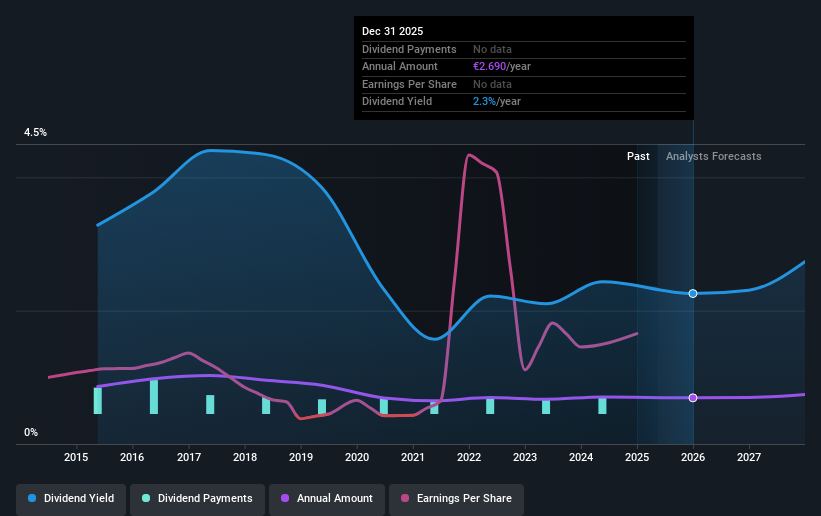- Netherlands
- /
- Diversified Financial
- /
- ENXTAM:HAL
HAL Trust (AMS:HAL) Looks Interesting, And It's About To Pay A Dividend
HAL Trust (AMS:HAL) is about to trade ex-dividend in the next 3 days. The ex-dividend date generally occurs two days before the record date, which is the day on which shareholders need to be on the company's books in order to receive a dividend. The ex-dividend date is an important date to be aware of as any purchase of the stock made on or after this date might mean a late settlement that doesn't show on the record date. Thus, you can purchase HAL Trust's shares before the 20th of May in order to receive the dividend, which the company will pay on the 27th of May.
The company's next dividend payment will be €2.90 per share, on the back of last year when the company paid a total of €2.90 to shareholders. Calculating the last year's worth of payments shows that HAL Trust has a trailing yield of 2.4% on the current share price of €119.20. We love seeing companies pay a dividend, but it's also important to be sure that laying the golden eggs isn't going to kill our golden goose! So we need to check whether the dividend payments are covered, and if earnings are growing.
We check all companies for important risks. See what we found for HAL Trust in our free report.Dividends are typically paid from company earnings. If a company pays more in dividends than it earned in profit, then the dividend could be unsustainable. HAL Trust paid out just 22% of its profit last year, which we think is conservatively low and leaves plenty of margin for unexpected circumstances.
When a company paid out less in dividends than it earned in profit, this generally suggests its dividend is affordable. The lower the % of its profit that it pays out, the greater the margin of safety for the dividend if the business enters a downturn.
See our latest analysis for HAL Trust
Click here to see how much of its profit HAL Trust paid out over the last 12 months.

Have Earnings And Dividends Been Growing?
Businesses with strong growth prospects usually make the best dividend payers, because it's easier to grow dividends when earnings per share are improving. If business enters a downturn and the dividend is cut, the company could see its value fall precipitously. It's encouraging to see HAL Trust has grown its earnings rapidly, up 42% a year for the past five years.
Many investors will assess a company's dividend performance by evaluating how much the dividend payments have changed over time. HAL Trust has seen its dividend decline 2.4% per annum on average over the past 10 years, which is not great to see. It's unusual to see earnings per share increasing at the same time as dividends per share have been in decline. We'd hope it's because the company is reinvesting heavily in its business, but it could also suggest business is lumpy.
To Sum It Up
From a dividend perspective, should investors buy or avoid HAL Trust? When companies are growing rapidly and retaining a majority of the profits within the business, it's usually a sign that reinvesting earnings creates more value than paying dividends to shareholders. This strategy can add significant value to shareholders over the long term - as long as it's done without issuing too many new shares. We think this is a pretty attractive combination, and would be interested in investigating HAL Trust more closely.
Want to learn more about HAL Trust? Here's a visualisation of its historical rate of revenue and earnings growth.
A common investing mistake is buying the first interesting stock you see. Here you can find a full list of high-yield dividend stocks.
Valuation is complex, but we're here to simplify it.
Discover if HAL Trust might be undervalued or overvalued with our detailed analysis, featuring fair value estimates, potential risks, dividends, insider trades, and its financial condition.
Access Free AnalysisHave feedback on this article? Concerned about the content? Get in touch with us directly. Alternatively, email editorial-team (at) simplywallst.com.
This article by Simply Wall St is general in nature. We provide commentary based on historical data and analyst forecasts only using an unbiased methodology and our articles are not intended to be financial advice. It does not constitute a recommendation to buy or sell any stock, and does not take account of your objectives, or your financial situation. We aim to bring you long-term focused analysis driven by fundamental data. Note that our analysis may not factor in the latest price-sensitive company announcements or qualitative material. Simply Wall St has no position in any stocks mentioned.
About ENXTAM:HAL
HAL Trust
Operates through multi-sectors in Europe, the United States, Canada, Asia, and internationally.
Flawless balance sheet and undervalued.
Market Insights
Community Narratives




